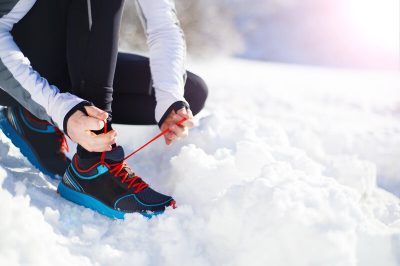 The time for winter sports and activities is upon us! Some people may be experienced winter sports enthusiasts, while others may be getting out to try something new. You might be skiing, snowboarding, hiking, or just having fun out in the snow – but there are important things to consider when it comes to the health and wellbeing of your feet! If you want to fully enjoy winter activities, you’ll want to protect yourself against cold weather foot injury. They can range from mild inconvenience or more severe causing you to be sidelined for a few weeks.
The time for winter sports and activities is upon us! Some people may be experienced winter sports enthusiasts, while others may be getting out to try something new. You might be skiing, snowboarding, hiking, or just having fun out in the snow – but there are important things to consider when it comes to the health and wellbeing of your feet! If you want to fully enjoy winter activities, you’ll want to protect yourself against cold weather foot injury. They can range from mild inconvenience or more severe causing you to be sidelined for a few weeks.
The team at Foot and Ankle Specialists of Illinois has dedicated their practice to the health and wellness of our patient’s feet and ankles. We want to provide you with the knowledge and know-how to keep your feet healthy, strong, and supportive so that you can enjoy everything the winter season has to offer!
1. Cracked Heels/Dry Skin
The most common cold-weather foot complaint, especially for men, is dry skin. Otherwise known as “heel fissures,” these cracks are unsightly and can cause pain when you’re on your feet.
The best way to help prevent heel cracks and dry skin on your feet is to apply moisturizer after a shower. But that may not be enough. Proper footwear with supportive heels can help prevent heel cracks, along with padded socks that cushion the heels.
If dry skin is left untreated, calluses and hard skin may develop on the heels. You can use a pumice stone to reduce the thickness of hardened skin. It is always a good idea to consult a foot health professional or dermatologist to do it for you, as it can put you at risk of infection, and can be dangerous for diabetics.
2. Athlete’s Foot
Most people consider Athlete’s foot a summer problem, probably because the condition is closely attributed to sweating and bacteria. However, this condition still occurs in winter, especially as you begin to layer up and get active. Heavy socks trap sweat and warmth, creating the perfect conditions for Athlete’s foot to develop.
You can prevent this problem by wearing socks with acrylic blends, which are excellent at wicking moisture away from the feet. This is particularly important for people who plan on engaging in strenuous winter activities like running, hiking, or other sports like snowboarding.
Visit our full page on Athlete’s Foot by clicking here
3. Blisters
There is no particular season for blisters, rather there are scenarios that put you at an increased risk of developing them. Winter gear such as skates, boots, or ski equipment might be the wrong size or not ‘broken-in’. Equipment that is the wrong size allows for movement and abrasion, while brand new gear will be very stiff and cause rubbing/irritation. Blisters are a particularly annoying cold weather foot injury that may put you at risk of more serious conditions like infections!
You don’t need to be an athlete to get blisters! The holiday season has us all running around, shopping, and doing chores in preparation for family get-togethers. All that extra time on your feet causes wear that can lead to blisters.
The solutions are simple, wear gear that fits, snug but not too tight. Also, wear thicker socks that protect your feet from abrasion and chafing.
4. Fractures
Winter sports involve an added layer of difficulty. Slippery, icy, uneven surfaces are a common aspect of winter sports and environments. This puts you at a much higher risk of falling, slipping, and losing your balance unexpectedly. You should consider wearing enhanced grips, such as spikes when walking in icy conditions.
Winter activities require a greater level of balance and stabilizing muscle strength. If you are new to these winter activities, you should be training and preparing your body, to help prevent against injury.
Skiers, skaters, and snowboards are especially prone to fractured ankles or metatarsal injuries. Running or simply walking on uneven, icy surfaces also increases the risk of a foot fracture. Read more about foot fractures by clicking here!
5. Tightness and Tendonitis
Cold weather can cause tension and tightness in the muscles and tendons in the body. Cold muscle and connective tissues are less elastic when cold and are at an increased risk of sprain or tear when subjected to force. Cold temperatures also limit your mobility and dexterity, meaning you may not be able to perform coordinated movements, leading to awkward falls and tripping injuries.
This 2016 study shows that muscle tissue that has fallen below 32 degrees requires less energy to fail. This means that as the core temperature of muscles drops, it becomes more likely that a person will suffer a tear or injury when exposed to high-impact energy.
The best way to prevent this is to make sure you are adequately prepared for winter activities and if possible, perform warm-up exercises to get the blood flowing to your extremities before engaging in demanding movements.
Visit our full page on tendonitis by clicking here
Cold Weather Foot Injury Therapy Available in Algonquin, Illinois
If you or a loved one are worried about foot and ankle injuries this winter, reach out to the experts at Foot and Ankle Specialists of Illinois today! Our team is happy to answer any questions you may have and are standing by in case of injury. If you are living with a painful foot/ankle condition, call our offices to speak with a member of our team or schedule a consultation online today!

